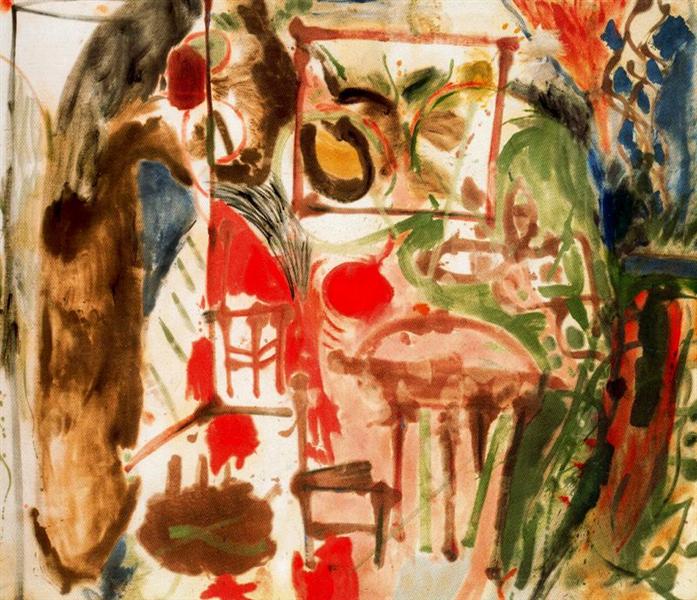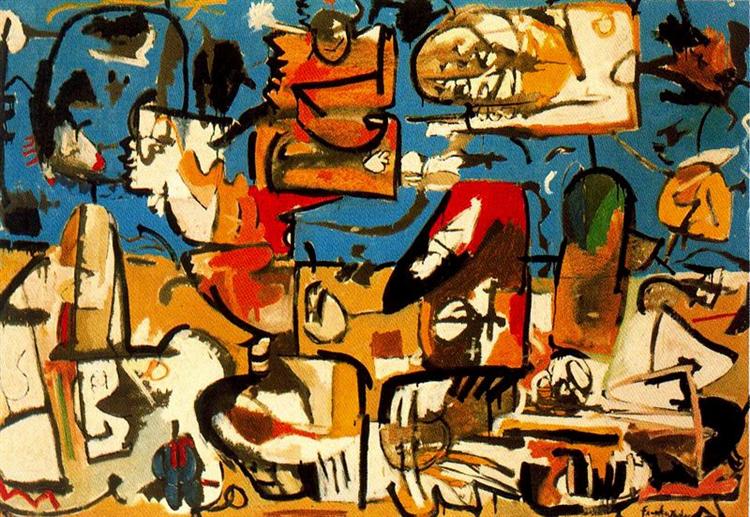Helen Frankenthaler was a pivotal figure in American abstract expressionist painting. Born in New York City on December 12, 1928, she became prominent in the 1950s art scene. There are instances where Frankenthaler’s artwork is associated with the Colour Field movement, which is typified by large colour washes painted on unprimed canvas. One of her best-known works, “Mountains and Sea” (1952), is recognised as a foundational piece in the history of abstract expressionism. She poured diluted paint straight onto the canvas and used her unique “soak-stain” technique to create flowing, organic shapes and vibrant colour fields.
Helen Frankenthaler was a major figure in the abstract expressionist movement of the 20th century. She became especially well-known for creating the revolutionary “soak-stain” technique, which involved sprinkling paint over a canvas and allowing it to absorb to create vivid, surreal effects.
Frankenthaler’s soak-stain technique changed abstract painting and impacted painters in succeeding generations. This method accentuated the paint’s transparency and fluidity instead of many of her contemporaries’ dense impasto approach. Abstract expressionism and color-field painting were connected by Frankenthaler’s artwork. Her emphasis on large colour expanses contributed to the development of colour field painting even though she was a member of the abstract expressionist movement.

Her work influenced many artists, including Morris Louis and Kenneth Noland, who expanded the ideas of colour field painting. Later generations of painters who wanted to experiment with different painting mediums and techniques were also affected by her approach. Frankenthaler was one of the few well-known female artists in the predominately male genre of abstract expressionism . Her fame and accomplishments dispelled the prevalent gender preconceptions in the arts and opened doors for other female artists.
Landscaping Helen Frankenthaler
Helen Frankenthaler, an abstract expressionist painter, employs abstract painting techniques while maintaining ties to the familiar, particularly to nature. She uses her emotions, experiences, aesthetic sensibility, and artistic training to paint massive abstract canvases. Frankenthaler’s abstract paintings are more than just random paint splatters or shapes. Her paintings and other sources of inspiration are related. By combining abstraction with her surroundings, Helen Frankenthaler is able to acquire deeper meanings. But her paintings don’t look like the natural world. They could be called “interior landscapes.”
Rather than deliberately beginning to paint a landscape, Frankenthaler lets her ideas and feelings guide her as she pours paint onto a canvas on the floor. Frankenthaler paints environments with this technique. Most of Frankenthaler’s paintings, if not all, show how abstraction and landscape are related.

Mountains and Sea, Frankenthaler’s most famous work from 1952, is also the critical piece that began the rest of her career. It is a masterpiece of her abstract landscapes and the picture in which she debuted her much-heralded stain painting . Frankenthaler has been addressing the seeming contradiction between nature and abstraction in most of her works since 1952. This research examines many pieces from the 1950s, 1960s, and 1970s to highlight this theme in Helen Frankenthaler’s work.
The landscape is a loaded question for an abstract painter. When one looks at an abstract horizontal canvas, one more or less consciously perceives nature or a horizon or view. One is not apt to think of a symbolic reference, which is more apt to be vertical. Looking specifically for figures or landscapes in abstraction can sometimes inhibit recognising a picture’s true quality. I am affected by nature, and I have made many paintings both ‘about nature’ and those that imply the figure, but it’s not a primary concern of mine.— Helen Frankenthaler
Most people picture the vast vistas of the romantic and idealised Hudson River School or the stunning landscapes of Dutch painters in the seventeenth century. Modern landscape art, however, does not depict conventional bucolic rural scenes. Frankenthaler’s art perfectly illustrates the modern landscape since it represents both the inner and outer worlds of the mind and the outside.

‘Although Frankenthaler’s staining technique, her influence on other artists and her femininity in contrast to the macho male Abstract Expressionist are exciting topics. I do not want to look at Frankenthaler as a woman artist but as an artist. I do not want to follow the conventional route and emphasize the importance of her stain technique and influence on other artists. Her prolific career is too often seen as an aftermath of her watershed work, Mountains and 3 Sea; more accurately, Helen Frankenthaler has explored many ideas, styles and techniques from the 1950s to the present. I will explore her work and one theme in particular, the landscape and its relationship to abstraction and her innovative staining technique, writes Morgan Ridler.
According to Morgan Ridler, ‘one of the oldest traditions in American painting is the landscape. The terrain of North America provides an endless supply of artistic inspiration. The American land represents individualism, freedom and spirituality. From the green forests and rolling hills of the northeast to the deserts of the southwest and everywhere in between, the American countryside is a subject that will continue to be utilized by American artists, including Frankenthaler. Generations of artists, from the Hudson River School of Painters to modern landscape artists, have painted the American environment. The Hudson River School used romantic ideals of beauty and the sublime to paint soaring views of the Rocky Mountains and majestic panoramas of the Hudson River valley. The early modernist painters Arthur Dove, Marsden Hartley, John Marin and Georgia O’Keeffe also used the seven landscapes as a means of expression. The American landscape tradition will always be vital to American painting.’
“The only rule is that there are no rules. Anything is possible. It’s all about taking deliberate risks.” – Helen Frankenthaler.
Woodcuts of Helen Frankenthaler
A crucial quality of an artist whose work develops via experimenting is determination. Frankenthaler can unleash a spontaneous yet deliberate gesture because of her innate awareness of precisely what is needed to balance line, form, and colour within a specific pictorial space: “To make the entire surface appear felt and born all at once, you must learn how to use the accident, how to recognise it, how to control it, and ways to eliminate it.” Frankenthaler realised early in her career that she needed to constantly push herself and work outside her comfort zone to grow as an artist and improve aesthetically.

Nothing is more artistically dissimilar from the world of a gestural, impulsive painter than the woodcut, a famously challenging and stiff medium. Frankenthaler’s method of painting is based on having a conversation with the painting itself—”a fighting, loving dialogue with this material.” You press it till you know this is correct, and it responds with an answer. She is directed and emerges out of the work to some extent. Therefore, the artist’s approach or the rules controlling the medium must change when creating a woodcut, which calls for meticulous planning and countless technical modifications. Frankenthaler was keen to master the woodcut rather than understand its language because he considered it challenging.
Helen Frankenthaler’s woodcuts demonstrate the experimental style of an artist who has maintained her creative edge for over 50 years by willfully breaking the conventions. Even in her advanced years, Frankenthaler’s influence as a youthful painter has endured, not only because she is a talented general artist but also because she is an exceptional woodcut artist. Opting against the norm is not a simple task. Nevertheless, Frankenthaler has always gone with her gut and is among the few modern artists who have given the most antiquated printmaking methods a fresh, modern energy.
Helen Frankenthaler is a legendary figure in 20th-century art who profoundly influenced the development of abstract painting. She captured the essence of emotion and movement in vivid hues, transforming the canvas into a place of ethereal beauty with her inventive soak-stain method. Frankenthaler’s work pushed the frontiers of artistic expression. It encouraged generations of artists to explore new possibilities in abstraction by serving as a bridge between abstract expressionism and colour-field painting.





